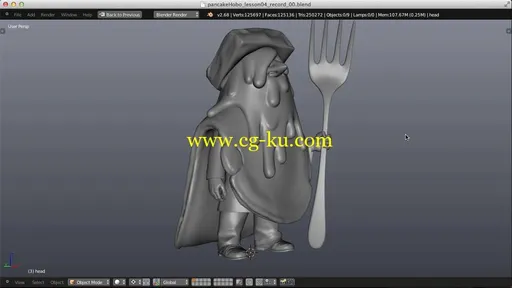
cgcookie - Texturing & Shading a Stylistic Character (Repost)
English | mp4 | H264 1280x720 | AAC 2 ch | 4 hrs 54 min | 1.92 GB
eLearning | Level: Intermediate | Software: Blender 2.68
Make your Cycles materials more tangible and appealing!
In computer graphics, “shading” is the process of developing surface qualities for 3D models. The way your model interacts with light is very important. It’s a key step in achieving realism, tangibility, believability, and appeal. If you ever have doubts about this, go watch the film “Rango”. The artists responsible for the visuals in that film clearly spent a lot of time perfecting the thousands of material types throughout the movie. The tangible quality of each eyeball, rock, wood board, and glass bottle is nothing short of stunning. The materials are so believable that you can forget to notice them because your brain accepts them as authentic.
If you’re new to the concept of shading, the best place to start is to intentionally observe reality. Take note of your car’s reflections; the spotty specular quality of an asphalt road; or the frosted transparency of a condensating glass of water. Lucky for you and I, scientists have done the hard work of measuring reality’s phenomenon and programmers have mathematically implemented them into 3D software like Blender. Thanks to those rockstars we have the freedom to use their discoveries and tools to more efficiently create something beautiful.
Speaking of something beautiful – For this course we’ll be working with the lovable “Pancake Hobo” character designed by Citizen user, Galit Weisberg!
So, how does one “Shade”?
Shading is more than simply building custom materials. Texture painting and Lighting go hand-in-hand with material creation and all three disciplines compliment one another. Therefore, the first half of this training course covers Texture Painting and associated tasks:
– Photo-sourcing and stenciling
– Paint-by-Hand
– Deriving a bump map from a color map
– Making non-tileable textures tileable
Then we’ll dive into material creation by first establishing a solid lighting setup before tackling each material one by one:
– Metallic Objects: The Fork
– Fabric Material
– Translucence/Subsurface Scattering: Butter, Skin, and Pancake
– Transparency/Refraction: Maple Syrup
– And more!
cgcookie-纹理 & 底纹文体特征 (转贴)
英语 |mp4 |H264 1280 x 720 |AAC 2 ch |4 小时 54 分钟 |1.92 GB
电子教学 |级别︰ 中级 |软件︰ 搅拌机 2.68
让你循环材料更实际、 更有吸引力 !
在计算机图形学中,"底纹"是开发 3D 模型的表面质量的过程。您的模型与光相互作用的方式是非常重要的。它是实现现实主义、 有形性、 可信性和上诉的关键一步。如果你曾经对此有疑问,去看电影"哥"。负责在那部电影的视觉效果艺术家显然花了大量时间完善上千种材料类型整部影片。每个眼球、 岩石、 木板和玻璃瓶的有形质量是简直令人惊叹的。这些材料是得更可信,你可以忘了注意到它们,因为你的大脑接受他们为真确的。
如果你是底纹的新概念,最好的地方开始是底纹的故意地观察现实。注意到你的车的思考;镜面反射质量的一条柏油路; 良莠不齐或磨砂的水冷凝玻璃的透明度。你是幸运的科学家们已经做测量现实的现象的努力工作和程序员数学上实现了他们到像搅拌机一样的 3D 软件。由于这些摇滚明星,我们有自由使用他们的发现和工具更高效地创建东西美丽。
说美丽的东西 — — 我们将工作与可爱的"煎饼流浪汉"字符由公民用户,嘉利韦斯伯格设计这门课程 !
那么,如何一个"荫凉"呢?
底纹不仅仅自定义的建材。纹理绘画和照明与材料创作手走在和所有的三个学科称赞对方。因此,上半年的这项培训课程涵盖了纹理绘制和相关的任务︰
— — 照片采购和制版
— — 手工油漆
— — 将一张凹凸贴图源于一个彩色地图
— — 制作非花木纹理花木
然后,我们将深入探讨物质创造第一在处理每一种材料逐一前建立一个坚实的灯光设置︰
— — 金属对象︰ 叉
— — 织物材料
— — 半透明/地下散射︰ 黄油、 皮肤和煎饼
— — 透明度/折射︰ 枫糖浆
— — 和更多 !